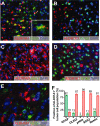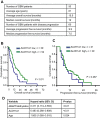ALDH1A1 is a marker of astrocytic differentiation during brain development and correlates with better survival in glioblastoma patients
- PMID: 22417385
- PMCID: PMC8057636
- DOI: 10.1111/j.1750-3639.2012.00592.x
ALDH1A1 is a marker of astrocytic differentiation during brain development and correlates with better survival in glioblastoma patients
Abstract
Glioblastoma is the most common malignant brain tumor and patients usually succumb to their disease within 2 years. Aldehyde dehydrogenase 1A1 (ALDH1A1) has been suggested as a marker for cancer stem cells that is associated with poor prognosis in human gliomas. However, little is known about the expression and the function of ALDH1A1 in early stages of brain development. We analyzed ALDH1A1 expression in developing and mature central nervous system (CNS) as well as in 93 cases of primary glioblastomas. Surprisingly, ALDH1A1 was absent in the stem cell niches at varying stages of CNS development, but strong ALDH1A1 expression was observed in mature astrocytes coexpressing GFAP and S100. There were 92 out of 93 glioblastomas (99%) that showed ALDH1A1 protein expression in up to 49% of tumor cells. The majority of these cells co-expressed GFAP, but not established stem cell markers such as Nestin, OLIG2 or SOX2. Finally, strong expression of ALDH1A1 correlated with a significantly better survival of the patients and proved to be an independent prognostic marker in our series (P < 0.01). In contrast to other published data, we therefore provide evidence for ALDH1A1 as a marker of astrocytic differentiation during brain development and of better prognosis in patients suffering from primary glioblastoma.
© 2012 The Authors; Brain Pathology © 2012 International Society of Neuropathology.
Figures






Comment in
-
Letter to the editor.Brain Pathol. 2012 Sep;22(5):724. doi: 10.1111/j.1750-3639.2012.00613.x. Brain Pathol. 2012. PMID: 22741744 Free PMC article. No abstract available.
-
Letter to the editor.Brain Pathol. 2012 Sep;22(5):723. doi: 10.1111/j.1750-3639.2012.00615.x. Brain Pathol. 2012. PMID: 22775573 Free PMC article. No abstract available.
References
-
- Grasbon‐Frodl EM, Kreth FW, Ruiter M, Schnell O, Bise K, Felsberg J et al (2007) Intratumoral homogeneity of MGMT promoter hypermethylation as demonstrated in serial stereotactic specimens from anaplastic astrocytomas and glioblastomas. Int J Cancer 121:2458–2464. - PubMed
-
- Hegi ME, Liu LL, Herman JG, Stupp R, Wick W, Weller M et al (2008) Correlation of O‐6‐Methylguanine methyltransferase (MGMT) promoter methylation with clinical outcomes in glioblastoma and clinical strategies to modulate MGMT activity. J Clin Oncol 26:4189–4199. - PubMed
Publication types
MeSH terms
Substances
LinkOut - more resources
Full Text Sources
Medical
Miscellaneous

